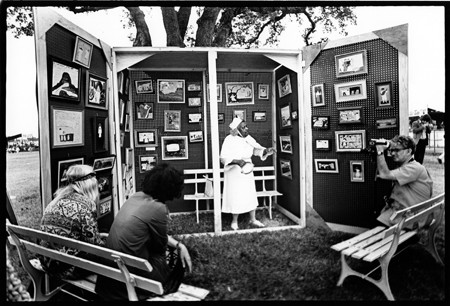Although those topics are not irrelevant, in my dissertation I argue for the permeability of the boundaries delimiting notions of artistic subjectivity and status of the folk art object through a study of the situations in which Morgan produced and presented her work. Critical in my approach is the artist’s agency in performance scenarios, and these instances structure each of my chapters. By seizing the transformative potential of performance—its capacity to enact meaning in doing, making, writing, or saying within contexts for which social roles may be prescribed, but never uncontested—I demonstrate the ways in which Morgan actively participated in the construction of her identities as
Chapter 1 presents Morgan’s self-portraits as a contemplative space in which she negotiated the personal implications of her Bridal Crowning, or revelation that she was the “Bride of Christ,” which she received in 1957. I employ visual and narrative analysis of her drawings and writings alongside readings of archival evidence, including census records, notarial documents, and city directories, to clarify the liberation accorded to Morgan in her sanctification, as well as the social constraints she had to negotiate in creating her visual self-representations.
Chapter 2 considers Morgan’s position beneath the banner of “heritage” through her inclusion in the New Orleans Jazz and Heritage Festivals from 1970 to 1974. Examining documentary photography, sound recordings, and Morgan’s correspondence, this chapter recovers the role of her art within a history of New Orleans jazz and African American performance. This trajectory was followed (if not also obscured) by national and regional visibility engendered by her paintings as “folk art.” The commodification of her oral performances and visual art provides an account of Morgan’s economic agency and weighs the ramifications of her pursuit of visuality in relationship with audibility.
Chapter 3 investigates the vectors of race, gender, and artistic training as they converged when two artists took Morgan as a subject for their paintings. Construing these gestures as modern alliances with an ostensibly traditional subject, I situate the art of Noel Rockmore (1928–1995) and Bruce Brice (b. 1942) within the cultural politics connected to these two artists in the 1970s and the place of “the folk” within those politics. In these cases, the space of the studio as a site of performance opens up onto local manifestations of black
My CASVA fellowship provided generous resources for following art-historical hunches and visiting unpredictable repositories, such as archives of popular music, to enrich the primary source materials of my investigation. Through that research and with the benefit of conversations with the other fellows, I have completed a draft of the dissertation that departs from a monographic structure. Instead, it offers a fine-grained analysis of aesthetic communication that acknowledges the way movements and textures of bodies and sounds, in addition to the visual, transmit knowledge. My analysis aims broadly to suggest an approach to studying self-taught artists that
Members' Research Report Archive
Sister Gertrude Morgan’s Material Performances and the Sensory Cultures in New Orleans, 1960‒1983
Elaine Y. Yau [University of California, Berkeley]
Wyeth Fellow, 2012–2014
Sister Gertrude Morgan (1900–1980) has been variously celebrated as a unique voice of the southern United States, a psychological and geographic “outsider” genius, and a quintessential “American” folk artist of the twentieth century. These interpretive rubrics contain grains of validity. Morgan was born and spent her childhood in rural Alabama, then longer periods in Columbus, Georgia, and New Orleans. Her membership in African American Baptist and Holiness-Pentecostal churches endowed her with a religious vocabulary and expressive repertoire resonant with gospel music. Furthermore, her art, which demonstrates a preoccupation with her status as a “Bride of Christ,” is replete with exuberant colors and gestural immediacy intended to induct viewers into otherworldly, biblical realms about which Morgan preached. The objectifying impulses of these discourses, however, sustain

Michael P. Smith, Sister Gertrude Morgan at the New Orleans Jazz and Heritage Festival, 1972. The Historic New Orleans Collection, 2007.0103.2.210